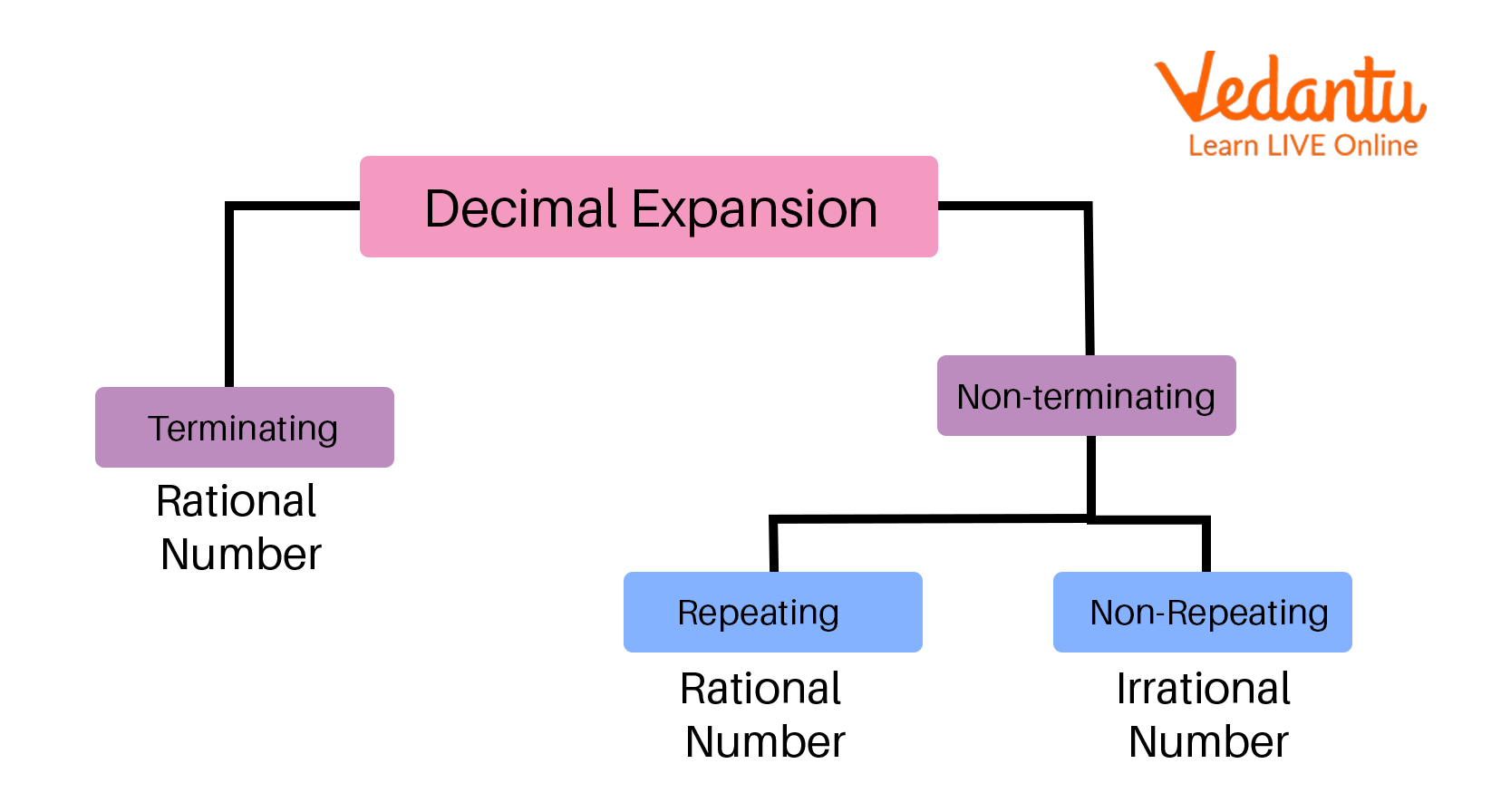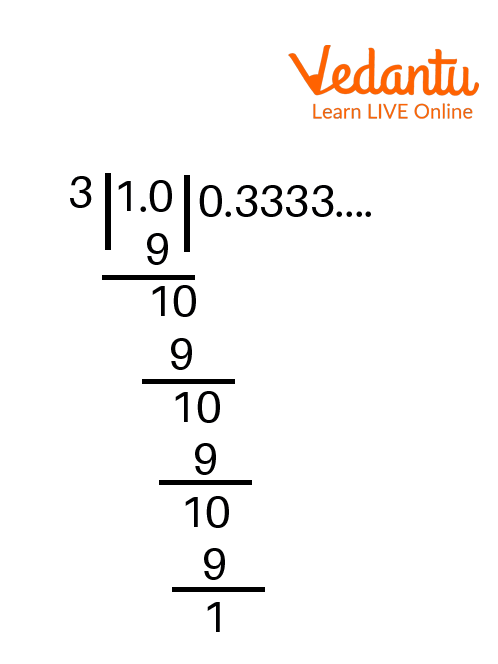




How to Distinguish Terminating and Non-Terminating Decimals
Let's first define rational numbers before discussing how they are represented when expanded to decimal form. The term "rational number" refers to any number that can be expressed as $\dfrac{p}{q}$, where $p$ and $q$ are integers and $q\neq 0$. Decimals are what is produced when these numbers are further simplified. Let’s learn more about the decimal expansion of rational numbers through this article.
Examples: $3, -5.8, \dfrac{4}{6}$.
Decimal Expansion of the Rational Number
The decimal expansion of a rational number is obtained by dividing the numerator by the denominator of the rational number.

Decimal Expansion
Types of Decimal Expansion
By dividing a rational number's numerator by its denominator, one can get the decimal expansion of a rational number. Two types of decimal numbers may result from this process.
Terminating Decimal Numbers
Non-Terminating Decimal Numbers
Terminating Decimal Numbers: Terminating decimal numbers are those decimal numbers with a limited number of digits following the decimal point. These decimal integers can be expressed in the $\dfrac{p}{q}$ form, where $q$ is not equal to $0$.
For example,
$2.4, 4.436$ are the terminating decimal numbers.
$2.4$ is represented as $\dfrac{24}{10}$.
Here, $p=24$ and $q=10$ and the number of decimal places $=1$.
Non-terminating Decimal Numbers: Non-terminating decimal numbers are those that have an endless number of digits following the decimal point.
Non-terminating decimal numbers include, for instance, $0.3333…, 4.53333…, and 5.3431034310…$.
How to Expand Rational Numbers in Decimals
Whole numbers, natural numbers, and integers are all examples of rational numbers because they can all be expressed in $\dfrac{p}{q}$ form, as we have explained. Decimal numbers that are stated as rational numbers may be repeating decimals that terminate or do not.
Example: Find the decimal expansion of $\dfrac{1}{3}$.
Let's divide the numerator by the denominator.

Decimal Expansion
$\dfrac{1}{3}$ is expanded to its decimal value of $0.333333$.
In this case, the divisor is $3$, and each step's remainder is $1$.
Terminating Decimal Expansion of Rational Numbers
When the digits after the decimal point are either terminated or finite, a number has a terminating decimal expansion. The decimal expansion for the fraction $\dfrac{5}{10}$ is $0.5$, which is known as a terminating decimal expansion since digits after the decimal point stop after one digit.
Non-terminating Decimal Expansion of Rational Numbers
The term "repeating" or "recurring" indicates that the repetition of the decimal values leads to a recognisable pattern that is easy to recognise, even though the decimal places in this expansion will never end and carry on forever. The expression $dfrac29=0.2222222$ is an illustration of a non-terminating recurring decimal expansion. For example, $0.222222...$ can also be written as $overline0.2$, demonstrating decimal repetition.

Non-terminating Decimal Expansion
Irrational Numbers Decimal Expansion
The use of decimal numerals to indicate an irrational number's most accurate value is referred to as the "decimal representation of irrational numbers." Non-terminating decimals with non-repeating digits are used to represent irrational numbers. For instance: Let's consider $\sqrt{2}$.
Attempting to write $\sqrt{2}$. For example, to $5$ decimal digits in decimal form, we have
$\sqrt{2} = 1.41421…$ If we enlarge √$\sqrt{2}$ to $10$ decimal places then we get $\sqrt{2}=1.4142135623…$
Interesting Facts
Any number that can be stated as a fraction is rational.
The examples include rational numbers: whole numbers, integers, fractions of integers, and terminating decimals.
Rational numbers also include recurring decimal patterns and non-terminating decimals.
A fraction is regarded as negative if it has a negative sign, either in the numerator, the denominator, or the fraction itself.
Solved Examples
Example 1: How would you characterize the prime factorization of the denominator of 42.123456789?
Solution: Since 42.123456789 is a decimal number with a terminating expansion, its denominator has the form $2^m 5^n$, where $m$ and $n$ are positive integers.
$43.123456789 =\dfrac{43123456789}{1000000000}$
$=\dfrac{43123456789}{(10)^9} \\$
$=\dfrac{43123456789}{(2 \times 5)^9} \\$
$=\dfrac{43123456789}{2^9 \times 5^9}$
Hence, it has prime factorisation in the terms of 2 and 5.
Example 2: How many digits does the rational number $\dfrac{1}{2^6 \times 5^2}$ end-on?
Solution: Let's use a whole number as the denominator.
$\dfrac{1}{2^6 \times 5^2}\\$
$=1\times \dfrac{(5^4)}{(2^6 \times 5^2 \times 5^4)}\\$
$=\dfrac{625}{2^6 \times 5^6}\\$
$=\dfrac{625}{1000000}\\$
$=0.00000625$
The supplied rational number thus comes to an end at six decimal digits.
Practice Questions
Which of the following is the decimal representation of $\dfrac{5}{13}$ ?
$0.\overline{384615}$
$0.384384$
$0.\overline{384}$
None of these
0 is not a
Rational number
Irrational number
Whole number
Natural number
Answers
(A)
(D)
Summary
Let's summarise everything we've learnt in this article. Fractions can be used to represent rational numbers. Decimal numbers come in two varieties: repeating and non-repeating for the terminating and non-terminating numbers, respectively. Rational numbers are real numbers that repeat or terminate. For further information on rational numbers and their decimal expansions, have a look at some of the cases that have been solved and are provided in this article.
FAQs on Decimal Expansion of Rational Numbers Explained
1. What is meant by the decimal expansion of a rational number?
The decimal expansion of a rational number is its representation in the base-10 number system. When a rational number (a fraction in the form p/q, where q ≠ 0) is converted into a decimal, the result is its decimal expansion. This expansion can be of two types: terminating (it ends after a finite number of digits, e.g., 1/4 = 0.25) or non-terminating but repeating (it has a block of digits that repeats indefinitely, e.g., 1/3 = 0.333...).
2. How can you determine if a rational number has a terminating or non-terminating decimal expansion without performing division?
You can determine the nature of a rational number's decimal expansion by examining the prime factors of its denominator. First, simplify the fraction to its lowest terms. If the prime factorization of the denominator contains only powers of 2, powers of 5, or both (i.e., it is in the form 2ⁿ5ᵐ, where n and m are non-negative integers), then the decimal expansion will be terminating. If the denominator has any other prime factor (like 3, 7, 11, etc.), the expansion will be non-terminating and repeating.
3. What is the difference between a terminating and a non-terminating repeating decimal? Provide examples.
The key difference lies in whether the digits after the decimal point end or continue in a pattern.
Terminating Decimals: These have a finite number of digits after the decimal point. The division process ends with a remainder of zero. For example, 5/8 = 0.625.
Non-Terminating Repeating Decimals: These have an infinite number of digits, with a specific sequence of digits that repeats forever. The division process never ends. For example, 4/11 = 0.363636..., which is written as 0.36.
4. How does the decimal expansion of a rational number fundamentally differ from that of an irrational number?
The fundamental difference lies in the pattern of the decimal digits. A rational number will always have a decimal expansion that is either terminating (e.g., 0.5) or non-terminating but repeating (e.g., 0.1666...). In contrast, an irrational number (like π or √2) has a decimal expansion that is both non-terminating and non-repeating. There is no predictable pattern in the digits of an irrational number, and they continue infinitely.
5. Determine if the fraction 15/1600 has a terminating decimal expansion and explain why.
Yes, the fraction 15/1600 has a terminating decimal expansion. Here's the explanation:
Simplify the fraction: First, simplify 15/1600 by dividing both the numerator and denominator by their greatest common divisor, which is 5. This gives 3/320.
Prime factorize the denominator: Now, find the prime factors of the new denominator, 320. 320 = 32 × 10 = 2⁵ × (2 × 5) = 2⁶ × 5¹.
Check the condition: The prime factors of the denominator are only 2 and 5. Since the denominator is in the form 2ⁿ5ᵐ (specifically 2⁶5¹), the decimal expansion is terminating.
6. What is the step-by-step process to find the decimal expansion of the rational number 13/3125?
To find the decimal expansion of 13/3125, you can use the property of terminating decimals.
Factorize the denominator: The denominator is 3125, which is 5⁵.
Make the denominator a power of 10: To make the denominator a power of 10 (10ⁿ), we need to have equal powers of 2 and 5. Since we have 5⁵, we need to multiply both the numerator and denominator by 2⁵ (which is 32).
Perform the multiplication: (13 × 32) / (3125 × 32) = 416 / 100000.
Convert to decimal: Dividing 416 by 100,000 gives 0.00416. This is the terminating decimal expansion.
7. Why is a non-terminating but repeating decimal, like 0.666..., considered a rational number?
A non-terminating repeating decimal is considered rational because it can always be expressed as a fraction p/q. The repeating pattern allows us to use an algebraic method to convert it. For example, to convert 0.666...:
Let x = 0.666...
Multiply by 10 to shift the decimal: 10x = 6.666...
Subtract the first equation from the second: 10x - x = (6.666...) - (0.666...).
This simplifies to 9x = 6.
Solving for x gives x = 6/9, which simplifies to 2/3. Since 0.666... can be written as the fraction 2/3, it is, by definition, a rational number.
8. How can you convert a terminating decimal like 0.225 back into its rational form p/q?
To convert a terminating decimal into a rational number, follow these steps:
Write the decimal as a fraction: Write the digits after the decimal point as the numerator. The denominator will be 1 followed by as many zeros as there are decimal places. For 0.225, this is 225/1000.
Simplify the fraction: Find the greatest common divisor (GCD) of the numerator and the denominator and divide both by it. The GCD of 225 and 1000 is 125.
Final Form: 225 ÷ 125 = 9 and 1000 ÷ 125 = 8. Therefore, the rational form p/q is 9/8.























